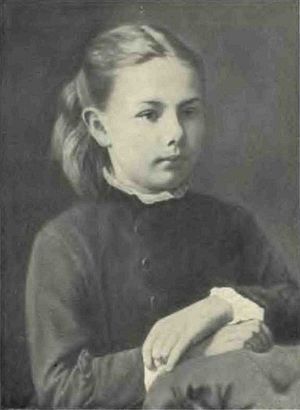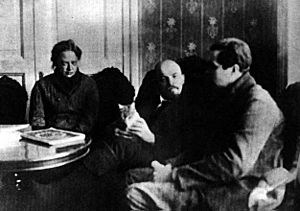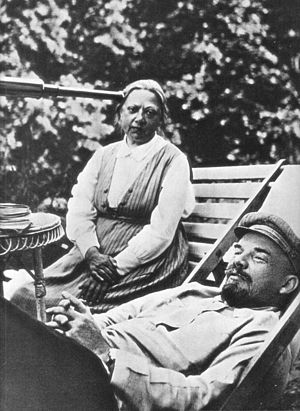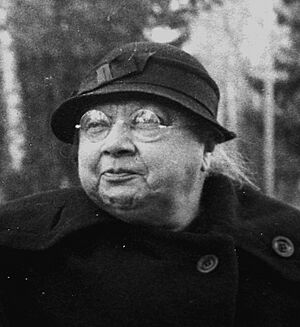Nadezhda Krupskaya facts for kids
Quick facts for kids
Nadezhda Krupskaya
|
|
|---|---|
|
Надежда Крупская
|
|
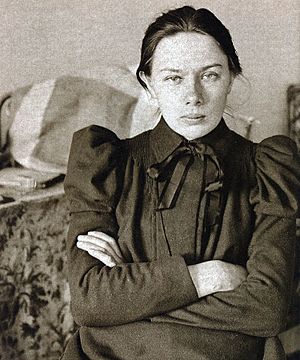
Nadezhda Krupskaya, 1890s
|
|
| Deputy Minister of Education in the Government of the Soviet Union | |
| In office 1929 – 27 February 1939 |
|
| Personal details | |
| Born |
Nadezhda Konstantinovna Krupskaya
26 February [O.S. 14 February] 1869 Saint Petersburg, Russian Empire |
| Died | 27 February 1939 (aged 70) Moscow, Russian SFSR, Soviet Union |
| Resting place | Kremlin Wall Necropolis, Moscow |
| Political party | Russian Social Democratic Labour Party (Bolsheviks) (1903–1918) Russian Communist Party (1918–1939) |
| Spouse | |
Nadezhda Konstantinovna Krupskaya (Russian: Надежда Константиновна Крупская, IPA: [nɐˈdʲeʐdə kənstɐnˈtʲinəvnə ˈkrupskəjə]; 26 February 1869 – 27 February 1939) was a Russian revolutionary. She was also the wife of Vladimir Lenin, a famous leader of the Russian Revolution.
Krupskaya was born in Saint Petersburg, Russia. Her family was once noble but had become poor. This made her want to help people who were struggling. She became interested in Marxism, a political idea about how society should be fair. In 1894, she met Lenin at a group where they discussed these ideas.
Both Krupskaya and Lenin were arrested in 1896 for their revolutionary actions. Lenin was sent away to Siberia. Krupskaya was allowed to join him in 1898, but only if they got married. After their time in exile, they lived in Munich and London. They briefly returned to Russia for the Revolution of 1905, which did not succeed.
After the 1917 Revolution, Krupskaya became a key figure in politics. She joined the Communist Party's Central Committee in 1924. From 1929 to 1939, she was a deputy minister for education. She had a big impact on how education and libraries were set up in the Soviet Union.
Contents
Early Life and Education
Nadezhda Krupskaya came from a family that had once been wealthy but was now poor. Her father, Konstantin Ignatyevich Krupski, was a military officer. He was orphaned when he was young. He became an officer in the Russian Army. After serving for six years, he faced problems with his leaders. He was suspected of being involved with revolutionaries. He then worked in factories to find work.
Krupskaya's mother, Yelizaveta Vasilyevna Tistrova, also came from a noble family that had lost its land. Her parents died when she was young. She went to the Bestuzhev Courses, which was the best education for women in Russia at that time. After her studies, she worked as a governess for noble families.
Having educated parents and seeing how poor people lived shaped Krupskaya's beliefs. She felt strongly about unfairness. One friend described her as a quiet girl with strong beliefs. She went to a special private school in Petersburg. This school was more open-minded than others.
After her father died, Krupskaya and her mother gave lessons to earn money. Krupskaya always wanted to work in education. She was very interested in Leo Tolstoy's ideas about teaching. He believed in helping each student grow personally. He also thought the bond between teacher and student was very important.
Krupskaya studied Tolstoy's ideas about peaceful change. These ideas focused on people living simply and being self-reliant. Tolstoy's views influenced Krupskaya deeply. She always dressed simply and kept her home modest.
Krupskaya joined several discussion groups. These groups met to study different topics. In one of these groups, she learned about the ideas of Karl Marx. She thought these ideas could help improve life for people. She began to study Marxism in depth. This was hard because the Russian government had banned books on the subject. Revolutionaries kept these books in secret libraries. In 1890, she joined a Marxist group. The next year, she started teaching at a Sunday school for adult workers.
Meeting Lenin and Married Life
Krupskaya first met Vladimir Ilyich Ulyanov (later known as Lenin) in February 1894. They met at a discussion group similar to hers. She was impressed by his speeches. We don't know much about their personal relationship. They both kept their private lives very quiet.
In October 1896, Krupskaya was arrested, a few months after Lenin. She was held in a fortress for a short time. She was then sentenced to three years of exile in Ufa. Before she left, she got a secret message from Lenin. He suggested she could join him in Siberia if she said they were engaged. Krupskaya was allowed to go to Siberia. She joined Lenin in May 1898, but only after they got married. Her mother traveled with her.
Krupskaya wrote in her memories that working with Lenin, even on translations, was a "labour of love."
It is thought that Krupskaya had Graves' disease. This illness affects the thyroid gland. It can cause problems with the eyes and neck. It can also affect a woman's ability to have children. This might explain why Lenin and Krupskaya never had children.
After Lenin was released from exile, he went to Europe. He settled in Munich. When Krupskaya was released in 1901, she joined him. Later, they moved to London.
Political Work and Later Life
Krupskaya was very active in politics. She was an important member of the Bolshevik group from 1903.
Leon Trotsky, who worked closely with Lenin and Krupskaya, wrote about her key role. He said she was at the center of all the organizing work. She met with comrades, gave them instructions, found secret addresses, and handled coded messages. Her room often smelled of burned paper from secret letters.
Krupskaya became a secretary for the Central Committee in 1905. She returned to Russia that year. But after the failed revolution, she left again. She worked as a teacher in France for a few years.
After the Russian Revolution in 1917, she became a deputy to the People's Commissar for Education. She led the adult education division. She became the head of the education committee in 1920. From 1929 to 1939, she was the deputy education minister.
Krupskaya played a huge part in setting up the Soviet education system. She also helped develop libraries in the Soviet Union.
Krupskaya joined the Central Committee of the Communist Party of the Soviet Union in 1924. She became a member of its control commission in 1927. In 1931, she became a member of the Supreme Soviet and an honorary citizen.
In December 1922, Lenin had a second stroke and was very ill. Krupskaya had a strong disagreement with Joseph Stalin. Stalin wanted to see Lenin, but Krupskaya said Lenin was too sick. She complained that Stalin had been very harsh with her. When Lenin found out, he was very upset with Stalin.
After Lenin died in January 1924, Krupskaya's political views changed. She sometimes sided with Grigory Zinoviev and Lev Kamenev against Leon Trotsky. Later, in 1925, she criticized Trotsky's ideas. However, in late 1925, she supported Zinoviev and Kamenev against Stalin. She even joined forces with Trotsky's group in 1926. But by December 1927, she had stopped opposing Stalin.
In 1930, Krupskaya again spoke out against Stalin. She defended other leaders who were being criticized. According to Nikita Khrushchev, a party official at the time, Krupskaya faced strong opposition for this. He remembered her looking "broken" after these meetings. Khrushchev also said that Stalin threatened to remove Krupskaya's status as "Lenin's widow."
Krupskaya wrote a book about her life with Lenin. It was called Memories of Lenin (or Reminiscences of Lenin). The book tells a lot about Lenin's life before he came to power.
Krupskaya died in Moscow on 27 February 1939. This was the day after her seventieth birthday. Her ashes were buried in the Kremlin Wall Necropolis.
Improving Soviet Education and Libraries
Before the revolution, Krupskaya taught evening classes for factory workers. She taught reading, writing, and math. She also secretly taught revolutionary ideas to those who were ready. She lost her job when many factory workers went on strike. Even after the revolution, she focused on helping young people learn and get organized. To be educated, people needed more access to books.
Before the revolution, Russian libraries were not open to everyone. Some were only for the rich. Others were only for workers of certain companies. Also, the books were often old-fashioned. It was hard to find new ideas, which is why secret libraries started. Another problem was that many people could not read. The Vyborg Library was later named the Nadezhda Krupskaya Municipal Library.
The revolution did not fix the libraries overnight. For a while, things were even harder. Trade unions still kept libraries private. There was little money for new books. The books they had were falling apart. Also, few people wanted to work in libraries because the pay was low. Libraries needed to be better organized.
Krupskaya ordered a count of all the libraries to fix these problems. She encouraged libraries to work together. She also wanted them to be open to everyone. She told librarians to speak simply with people. She wanted librarians to know what readers needed. They should know what books to stock and what subjects people liked. She also wanted them to organize materials better.
Krupskaya said at a library meeting: "We have very few libraries, and their book collections are even worse. Their quality is terrible. Most people do not know how to use them. They don't even know what a library is."
She also wanted better schools for librarians. Before the revolution, there was little formal training for librarians. Krupskaya pushed for "seminaries" where experienced librarians would teach new ones. Librarians were taught to choose suitable materials for patrons. They also learned to explain why certain books were better than others. She believed this was a way to help people learn about socialist values. Librarians were to help the revolution and keep its values alive.
Krupskaya was a strong believer in Marxism. She thought every part of public education helped improve people's lives. She wanted everyone to have access to education and libraries. She believed these tools would help people live more fulfilling lives.
Role During the Great Purge
Krupskaya was at a meeting in February 1937. At this meeting, it was decided that Nikolai Bukharin and Alexei Rykov would be removed from the Communist Party. Krupskaya voted for this. However, at other times, she tried to help people who were in trouble. In June 1937, she spoke out against the arrest of Osip Piatnitsky, but it did not work. She did manage to get an old revolutionary named I.D. Chugurin released. But he was not allowed to rejoin the party and worked as a roofer.
Legacy
- After her death in 1939, a chocolate factory in Leningrad was named after her. The Krupskaya chocolate bar still has her name today.
- An asteroid discovered in 1971 was named 2071 Nadezhda in her honor.
- Film director Mark Donskoy made a movie about her called Nadezhda in 1974.
- In 1974, Jane Barnes Casey wrote a fictional book about her life called I, Krupskaya: My Life with Lenin.
- UNESCO created a prize in her honor, the UNESCO Nadezhda K. Krupskaya literacy prize. This prize helps promote literacy.
- In a 1997 Estonian movie, All My Lenins, Nadezhda Krupskaya was played by actress Helene Vannari.
Images for kids
-
Board at a kindergarten in former East German part of Berlin-Spandau, Germany
See also
 In Spanish: Nadezhda Krúpskaya para niños
In Spanish: Nadezhda Krúpskaya para niños
- Kommunistka
- UNESCO Nadezhda K. Krupskaya literacy prize
- Clara Zetkin
- Rosa Luxemburg
- Alexandra Kollontai
- Inessa Armand
Works
- Memories of Lenin. New York: International Publishers, 1930. —Reissued as Reminiscences of Lenin.
- On Education: Selected Articles and Speeches. Moscow: Foreign Languages Publishing House, 1957.



